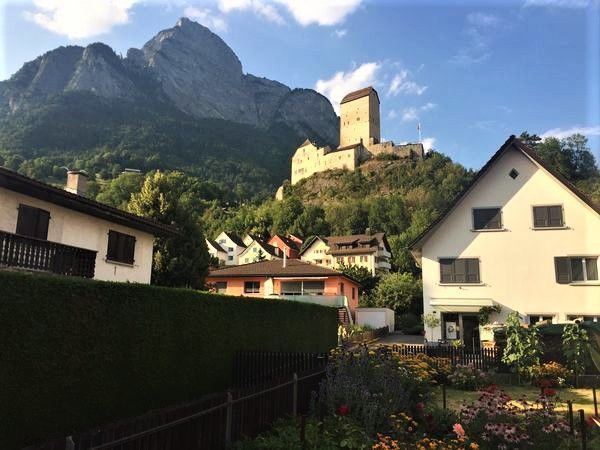
Your trip begins on arrival in Sargans. This working Swiss town has a fine old street and castle. With the village of Mels next door, the situation in the valley hints at the grand mountains to come. Dine at restaurants in either of these centres.
Hotel in Sargans or Mels (breakfast)

Red 3 (grade) 13.2km with 650m ascent, 130m descent
A short first stage climbs steadily in woods. We burst into the upper valley and walk up-river to the sweet village of Weisstannen. This brings us within reach of the first proper ascent of a pass. (It is also possible to use the bus to stay two nights in Sargans or Mels. Or, skip this stage if you wish to save a day. It's difficult to combine it with the stage to Elm.)
Hotel in Weisstannen (dinner and breakfast)

Red 3 (grade) 22.9km with 1290m ascent, 1320m descent
Leaving Weisstannen, continue on the valley road through cattle country to the head of the valley. Here starts the climb to the Foopass (2,223m), steeply up to a high valley and finally up grassy pasture. This first pass is grassy on both sides and relatively gentle. Descend to Elm on good paths and tracks.
Guesthouse in Elm (dinner and breakfast)

Red 4 (grade) 24.7km with 1525m ascent, 1715m descent
Leaving Elm, we head up to Ämpächli and traverse to the Obererbs skihutte before starting on the higher more steneuous ascent to Wichlenmatt (2160m) and Richetlipass (2261m). Once reached the Richetlipass, enjoy the fabulous wide view down to Linthal, an everyday Swiss village.
Hotel in Linthal (breakfast)

Blue 4 (grade) 23.7km with 1600m ascent, 300m descent
After the ascent to the village of Braunwald, the path flattens out and views open up onto various waterfalls and the valley below. From here weave on and off the road on a series of paths to the meadows of Urnerboden. As the slopes rise to the Klausenpass, take to meadow paths.
Hotel in Klausenpass (dinner and breakfast)

Red 3 (grade) 20.2km with 260m ascent, 1640m descent
Take in the views as you steeply descend from the Klausenpass towards the magnificent village of Asch famed for its 100m waterfall. The rest of the stage passes a few villages with a couple of grocery shops to stock up on a cold drink and snacks. Reach the historic town of Altdorf for the evening.
Hotel in Altdorf (breakfast)
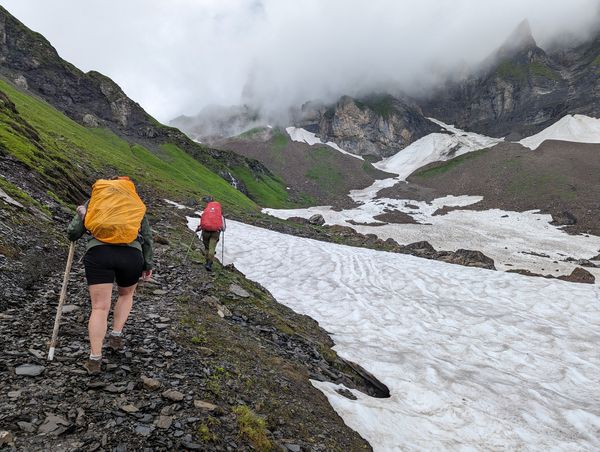
Purple 4 (grade) 29km with 1940m ascent, 1390m descent
This is a particularly memorable stage, perhaps the most demanding of the whole Via Alpina in terms of physical effort even if there are higher passes to come. The pass is the Surenenpass (2,291m) with a rocky approach. After the pass the long roll down to Engelberg follows the course of the valley, goes quickly, and is charming. The first ascent can be shortened by a cable car to Brusti, saving 1,080m and 3.5km.
Hotel in Engelberg (breakfast)
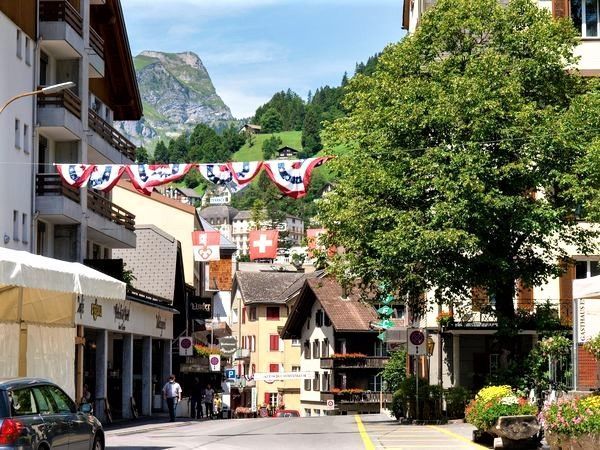
Take the train to Lucerne (Luzern) for a city day out and a dip in the lake; Engelberg is a branch line from Lucerne and trains run every hour. Or relax in Engelberg, perhaps taking the famous Titlis cable car.
Hotel in Engelberg (breakfast)

Red 3 (grade) 11.6km with 1260m ascent, 430m descent
Setting off from Engelberg, the Jochpass is the first col, relatively modest at 2,207m and with ski infrastructure on either side. Nevertheless, the mountains are building up and we descend to the delightful meadow of Engstlenalp and the start of a road. Here sits a fine old hotel, a large building. We are still a day from Meiringen in the next valley system. (The bus runs to Meiringen and it is also possible to walk beyond Engstlenalp to the cable car on the next stage, for those who prefer to save a day or to stay in town.)
Guesthouse in Engstlenalp (dinner and breakfast)

Red 3 (grade) 21.7km with 570m ascent, 1810m descent
Our main route is a hilly, at times narrow traverse via Tannalp to Planplatten, from where we begin the solid descent to Meiringen. On the way is the Balmeregghorn, a grassy hill with long views over meadows and the deep Gental. (At Planplatten a series of three cable cars can be taken to Meiringen to save some or all of the descent.)
Hotel in Meiringen (breakfast)
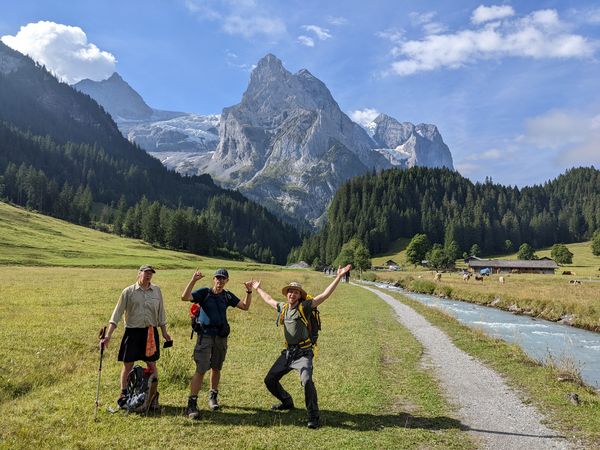
Blue 3 (grade) 22.9km with 1410m ascent, 990m descent
The passes continue with the easy-angled Grosse Scheidegg. A small road goes over the pass and down to Grindelwald. We climb and descend through woods and meadows. This feels like a more gentle day than others, despite the distance, because after the first ascent by the Reichenbach falls (as per Sherlock Holmes) the gradients are generally modest.
Hotel in Grindelwald (breakfast)

Red 3 (grade) 19.2km with 1170m ascent, 930m descent
The Kleine Scheidegg is today's pass, unique on the Via Alpina in hosting a railway station. (The Jungfraujoch railway can be joined here as an excursion.) We walk under the North Face of the Eiger. Roll gently down to Wengen on its high shelf. Together with Grindelwald and Murren, Wengen makes up the trio of famous Bernese Oberland resorts.
Hotel in Wengen (breakfast)

Blue 2 (grade) 8.7km with 870m ascent, 500m descent
Today is a modest stage, steeply down to Lauterbrunnen then steeply up. Our aim is the mountainside village of Murren, car-free and a curious delight. It feels as if suspended in mid-air. (The Grutschalp cable car and sweet old train can be used to bypass the stiff climb, thus skipping this stage and either missing Wengen or reaching Griesalp in a day.)
Hotel in Murren (breakfast)

Purple 3 (grade) 17.5km with 1100m ascent, 1330m descent
The first of the two toughest stages comes with the long climb to the Sefinafurgga (2,612m), the second-highest col of the whole Via Alpina. (The highest comes tomorrow.) The ascent is exceptionally scenic, with views over Murren and back to the Kleine Scheidegg. The Sefinafurgga is narrow, loose and rocky, and the descent to tiny Griesalp is quick down meadows.
Guesthouse in Griesalp (dinner and breakfast)

Purple 4 (grade) 15.5km with 1440m ascent, 1670m descent
The rocky Hohtürli (2,778m) col is not even the highlight of this exceptional day in the mountains. Perhaps the highlight is the Blüemlisalphütte (2,834m) just above the col, in classic Swiss Alpine Club style as a solid stone building with red and white-striped shutters, or the glacial views and features on the descent. We walk on a lateral moraine with waterfalls opposite. Today has the most consistently mountainous setting of all the Via Alpina stages.
Hotel in Kandersteg (breakfast)

Kandersteg is smaller than Engelberg and a train ride to Bern is easy to recommend. (Bern is the capital of Switzerland, and is unusual for its long arcaded streets.) In the other direction, the Rhone valley and even Zermatt are possibilities.
Hotel in Kandersteg (breakfast)

Purple 3 (grade) 16.5km with 1345m ascent, 1170m descent
The third of the Via Alpina's three rockiest passes is today, the Bunderchrinde (2,385m). It is a notch in the rock, framing the onward view to Adelboden. The initial descent path is rocky, steep and loose; lower down, the descent is fine and becomes gently pastoral. Adelboden is one of the most pleasant of Via Alpina resorts, its level high street hosting boutiques, retaurants and bakery.
Hotel in Adelboden (breakfast)

Red 3 (grade) 19.5km with 950m ascent, 1230m descent
Choose from two routes today, both crossing the mountains at the grassy Hahnenmoospass. We suggest the ascent to the Sillerenbuhl and descent via the Simmefalle, a long stepped waterfall in woods. (Our routecard describes a shorter route direct to the col and down to Lenk, and you are free to choose your route on either side of the col.) This is a gentler day than those before or after. Lenk is another charming small resort at the end of its train line.
Hotel in Lenk (breakfast)

Purple 3 (grade) 22.3km with 1070m ascent, 1090m descent
Our pass today is the grassy Trutlisbergpass. Begin with a waterfall in woods and emerge on high pastures. An easier alternative is the cable car from Lenk for a shorter ascent to the pass. After the grassy Trütlisbergpass, follows the Turpachbach into Gstaad - known for its lively resort atmosphere and good hotels.
Hotel in Gstaad (breakfast)

Red 4 (grade) 25.4km with 1460m ascent, 1550m descent
After a steep ascent from Gstaad, the route follows an increasingly interesting ridge to the grassy Col de Jable, also a linguistic border. After descending to the cheese producing capital of L’Etivaz, the route becomes gently undulating as it follows La Torneresse river into Château d’Oex.
Hotel in Château d’Oex (breakfast)

Red 4 (grade) 20.9km with 1860m ascent, 850m descent
Our route makes a gradual ascent to Linderrey with views of the Lac de l’Hongrin and its huge dam wall, followed by a steep grassy descent into the Hongrin valley. Then comes another big ascent through woodland to Col de Chaude and up an interesting ridge to the Rochers de Naye. From Rochers de Naye take the mountain railway for your night to Montreux.
Hotel in Montreux (breakfast)

Red 3 (grade) 11.6km with 50m ascent, 1640m descent
Once back at Rochers de Naye, begin the fabulous descent of the Rochers de Naye which becomes a clear and bold ridge with forests and Montreux below.
Hotel in Montreux (breakfast)

After a last breakfast we depart from Montreux, in what will feel like a very different environment to most of the trek. The paddle steamers on Lac Leman are a fine way to reach Lausanne or Geneva, clear blue water below and hills above. The train speeds to Geneva and then to Geneva Airport 6 minutes later, or by a pastoral route to Bern and Basel. We love to advise on Swiss travel. Congratulations on the Via Alpina!
Make the trip shorter
The simplest way to shorten the route is to either finish the hike in Rochers de Naye (missing out the final short stage) or to hike the final 2 stages in one long day. For both these options, we'd book 1 night in Montreux at the end of the trip, and you could decide on the day whether to hike the whole way or take the train to shorten the route.
By including some longer days, it’s possible to shorten the trip further still to 17 or even 16 stages. The changes come in the middle section: we would combine the 2 stages between Engelberg and Meiringen into 1 longer day, and the 3 stages between Grindelwald and Griesalp into 2 days, with a night in Lauterbrunnen in the middle. For week long section of the Via Alpina, we recommend our Via Alpina Bernese Oberland hike.
Walk a shorter portion of the Via Alpina
This trip works well split into 3 week-long sections - Sargans to Engelberg, Engelberg to Kandersteg, and Kandersteg to Montreux. Hike the three sections as seperate week long breaks and complete the entire route over a few years.
Take fewer or more rest days
Our normal trip includes 2 rest days, separating the three weeks into thirds. These days are in Engelberg and Kandersteg, villages of a reasonable size, with good hotels, and with rail links to Bern. You might prefer just 1 rest day, and this could be half-way in Grindelwald or Wengen, super Alpine resorts each with trains going up to the Kleine Scheidegg and Jungfraujoch. You'll know how many days you like to walk in one go, and what you'd like to see within Switzerland. We would love to advise.
For a rest date off route, why not spend 2 nights in Lucerne, Zurich or (our favourite) Bern. This could be an invigorating city break within your long hike.
Hike with a guide
Hike with confidence in the company of our fully qualified International Mountain Leaders (IMLs), with the navigation, accommodation and all arrangements taken care of. If your group would like a guide for your trip, please get in touch for more details.
Add a stage in Liechtenstein
Begin your hike with a short stage from Vaduz (Liechtenstein) to Sargans (Switzerland). We suggest 2 nights in Sargans for anyone who wants to consider inclduing this half day. Take the bus from Sargans to Vaduz and then walk back for a second night in Sargans.

|
Via Alpina 14 July to 18 Sept 2025 |
|||
| Classic | Comfy | ||
| Self-guided | |||
|
18 stages 2 rest days (21 nights) |
GBP 3,650 Singles 945 |
GBP 3,930 Singles 1,155 |
|
|
19 stages 2 rest days (22 nights) |
GBP 3,740 Singles 990 Main Trip |
GBP 4,040 Singles 1,210 |
|
| Options | |||
|
Baggage transfer |
Please ask us | ||
The accommodation on the Via Alpina is of high standard, using mostly 3* hotels, with delicious buffet breakfasts included each morning. Our trip stays in a mixture of hotels and guesthouses where you will have a private room each night. On occassion, if availability is tight at 2 of the guesthouses then we’ll let you know in advance; in that case the choice will be between dormitories or taking a scenic bus to a nearby hotel. No huts are needed on this trip, and for such a long trail in the Alps this is quite remarkable. It follows the pattern of village-pass-village. (As below, we can add 2 huts if you'd like to see that aspect of the route.)
Comfy
As standard, the accommodation on the Via Alpina is already a comfortable trip. If you'd like a little more comfort, we can upgrade your accommodation on 12 nights to 3* and 4* hotels. You'd still have 2 nights in guesthouses, in Elm and at Engstlenalp. (Ask us about the bus to Meiringen to swap Engstlenalp to a hotel.) If you'd prefer to stay on the route, please do let us know and we'd be happy to book you into our classic accommodation on those nights. We upgrade the guesthouse in Griesalp to a hotel.
Alpine Huts
The famous Swiss mountain huts are an excellent addition to any hike of the Via Alpina. Whilst we don’t book any hut accommodation as the norm, with each of our stages ending in the valley after a pass crossing, it is possible to incorporate a night at the Rotstockhütte after, or instead of, your night in Mürren. This would change the walking distances slightly; in return, you get the chance to experience typical Swiss hut charm, with accommodation in stunning mountain settings. Please ask us for more details.
Single Room Supplement
If you would like to stay in single rooms rather than sharing a double, twin or triple room we add our single room supplement to the overall cost. This covers the additional cost of booking single occupancy rooms. The single supplement is only applied to nights where single rooms are available. In the guesthouses, we may be able to book single rooms or if not, we will book the smallest room available.
Solo Travel
We do not take bookings for solo walkers on self-guided trips. If you are still interested in this trip, we do have availability on our guided trips.
 Steep descent from the Hohtürli on Stage 7
Steep descent from the Hohtürli on Stage 7
Our approach to the Via Alpina
The Via Alpina system is made up of 5 hiking routes across the whole Alpine chain. What we call our Via Alpina is in fact the Green Swiss Via Alpina. To confuse the picture, our Via Alpina (Alpine Pass Route) is also the Swiss National Route 1, within the Swiss system of trails. The full Via Alpina begins with 1 stage in Liechtenstein (Vaduz to Sargans) before crossing the Alpine chain in Switzerland as far as Lenk in the West. From Lenk, where the Green route Via Alpina ends, we follow the Swiss National Route 1 trail to Montreux.
On the trek itself, no transport is needed, but cable cars and buses can be used on many stages to shorten the walking if wanted. Public transport is also handy to upgrade guesthouses to hotels on certain nights. For example, use the postbus to reach Altdorf from the Klausenpass, to give a better choice of accommodation, and the train to reach Montreux from Rochers de Naye. Our routecards detail these transport options available on each day, and they tally with your Itinerary which details where you will stay, as well as pointing out where refreshments can be purchased. Where there is a choice of routes, we describe both options, allowing you to tailor the hike to suit your needs when possible.
The Terrain
The Via Alpina's terrain comprises the full range of Alpine walking: a typical day starts with wide tracks through forests or tarmac country lanes, then rises to zig-zagging hillside paths, or open meadow where narrow hard-pack paths cross grassland. Above, we venture into the high hills where good balance is needed on rocky paths and steps.
The four highest cols in particular, the Surenenpass (2,291m), Sefinafurgga (2,612m), Hohturli (2,778m) and the Bunderchrinde (2,385m), involve loose tracks over scree and shale. In descent from the Hohturli to the Oechinensee there is hard walking on rocky paths, with drops to one side (lateral moraines). Chains aid the scree ascent up to the Sefinafurgga; wooden ladders down from the Sefinafurgga and up to the Hohturli give solid walking. The Via Alpina has no via ferrata or climbing sections and is considered a walk throughout, albeit at times a very challenging one.
Is it for me?
The Via Alpina is perfect for stronger hikers looking for comfy stays overnight. Good footing and a head for heights is needed for crossing the (at times) extremely loose ground on the ascents and descents from the higher passes. In bad weather, experience is needed to judge whether walking is safe or whether passes should be avoided by taking the train or bus instead. Similarly, the ability to navigate with a map and compass is essential for at least one party member in case of poor visibility.
The high standard of accommodation on the Via Alpina and the option to have your bags transferred to every stop gives a little luxury and comfortable breaks along the route. The expansive cable car and postbus system allows for a certain flexibility to the walking, making it much easier to skip sections or even a whole stage of the route, compared to our other Alpine trips. Generally, life in Switzerland is simple, comfortable and predictable.
Difficulty
We grade the Via Alpina as a Purple4, making it one of our hardest treks. The hardest parts giving it this grade are the ascents and descents over the 4 high passes on stages 6, 12, 13 and 14. Not all the passes are like this though, with many offering grassy paths through Alpine meadows. In terms of distance, the route has 2 long days; the long crossing of the Surenenpass from Altdorf to Engelberg, and the day from Gstaad to Château d’Oex. Good public transport can help shorten these 2 and many of the other days, with 3.5km and 1,080m ascent being shaved off the crossing of the Surenenpass by taking the cable car.
 Walking Guide to the Via Alpina - our detailed read
Walking Guide to the Via Alpina - our detailed read
 The making of our Via Alpina - photos from our research trips
The making of our Via Alpina - photos from our research trips

The Via Alpina crosses the breadth of Switzerland and intersects numerous North-South bus and train routes. We walk within a short train ride of Lucerne (Luzern), Bern and then Lausanne. It will become enticing to see more of Switzerland! We are always delighted to chat about train routes after your trip, to various Swiss locations. Attractions include Switzerland's scenic rail lines, of course, and these are often reachable within a day trip off-route.
We love Bern as a Swiss city before, during or after your trip. Then fly from Zurich or Basel airports. We are glad to recommend hotels and parts of town in all of the larger Swiss cities.
Italy is eminently reachable after your trip, from several points. Chiefly, Altdorf and Kandersteg are on major North-South train routes, that plunge into tunnels and emerge in the Italian valleys running down to Milan. We have ridden these and other routes and we love to advise.
Travel to and from the trip is not included in the holiday price. We take care to give the most useful notes possible about all the travel options. We supply these both on booking and in your info pack, and we offer personalised tips at any point. The aim is that our trekkers arrange their travel by the simplest and most scenic means as suits their plan.
 Travel in Switzerland - our general page on Swiss trains
Travel in Switzerland - our general page on Swiss trains
- Bespoke accommodation itinerary - tailored to suit your particular requirements
- Breakfast every morning
- Dinner in Weisstannen, Elm, Klausenpass, Engstlenalp and Griesalp (more if staying in the huts)
- Detailed Routecards VAS1-VAS19 of the Exploratory system, printed on waterproof paper
- The 9 topographical maps needed
- Downloadable GPX Tracks covering the route
- Expert advice and local information
- A comprehensive 'Season Update' following our pre-season recce
- Full support during your trip from the Alpine Exploratory team (9am until 9pm in the Alps)
- Travel to and from your trip
- Local transport whilst on the trip unless specified
- Travel insurance
- Lunches, snacks, drinks and evening meals in the towns (this would be 18 nights on our main trip)
- Baggage transfers (available as an extra)
Baggage transfer
We offer baggage transfers as an extra to all stops on our standard Via Alpina. (Baggage transfers aren’t available to the huts, if you choose to add any huts).Due the high cost of transferring luggage by road and rail in Switzerland, we generally recommend that you carry everything you need for the trip on your back; there is not too much you need during your trek. We can also advise on more cost-effective ways of sending additional kit ahead to meet you on your rest days and at the end of your trip. If you would like more information about our baggage transfer service, please ask.
 
Enquiry Form
|
If you prefer, please feel welcome to email or call us. Thanks!
| Contact Alpine Exploratory | |
| info@alpineexploratory.com | |
| Phone | +44 (0)131 214 1144 |
| Our times |
9am to 5pm UK time Monday to Friday |
| Australia | 02 8319 2266 |
| Canada | 416-548-4819 |
| New Zealand | 04 889 4515 |
| USA | 646-757-1102 |
Open to the world
Since Alpine Exploratory started in 2005 we have loved getting to know our clients from around the world. Along with the UK, our best-represented countries are the US, Australia, Canada and New Zealand. Please use our national-rate numbers for a cheaper call to contact our office in Edinburgh.
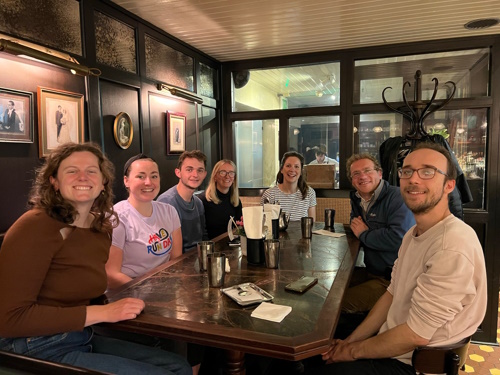
Keep up with us on Facebook, Instagram, and our Blog for photos and updates from our own travels and clients' trips.



 02 8319 2266 from Australia
02 8319 2266 from Australia 416-548-4819 from Canada
416-548-4819 from Canada 04 889 4515 from New Zealand
04 889 4515 from New Zealand 646-757-1102 from the USA
646-757-1102 from the USA




 Via Alpina Switzerland
Via Alpina Switzerland



 Walking from Meiringen to Grindelwald on Stage 9
Walking from Meiringen to Grindelwald on Stage 9





 Alpine Exploratory
Alpine Exploratory
 +44 (0)131 214 1144
+44 (0)131 214 1144
